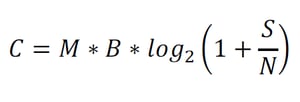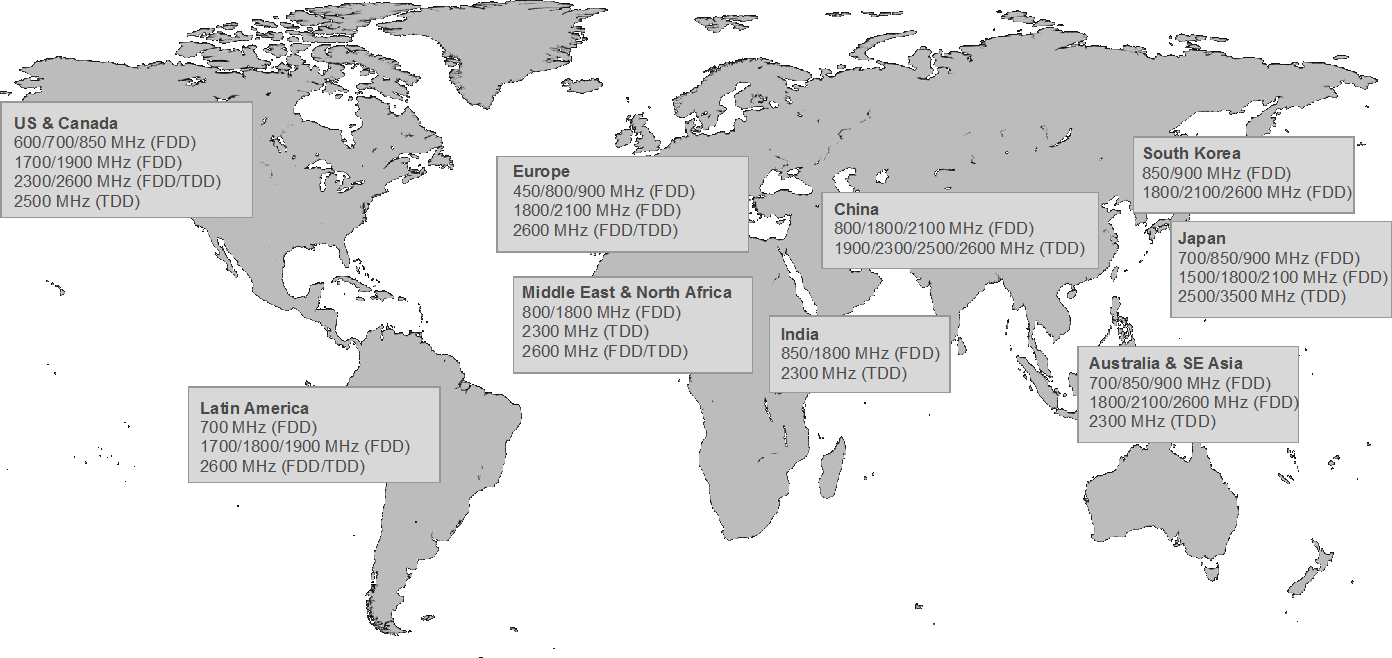Planning is in the works for Fifth Generation (5G) communication systems that will enable a hundred-fold increase in user data-rates – and with this increase comes a need for significant increases in bandwidth over what is currently available. Why does bandwidth follow when we ask for an increase in data rates?
In 1948 Claude Shannon and Ralph Hartley, both researchers at Bell Labs, developed what has become known as the Shannon-Hartley Theorem. It tells us the maximum amount of error-free digital data that can be transmitted over a channel of a given bandwidth in the presence of noise:

Where:
C = Channel capacity in bits/second
M = Number of channels (e.g. the MIMO order)
B = Bandwidth in hertz
S = transmit power, in watts
N = noise on channel, in watts
S/N = signal to noise ratio
To increase channel capacity (data rates) we can increase bandwidth, increase the number of channels, increase transmit power (S) and decrease the noise on the channel (N).
In order to achieve the data rates targeted by 5G systems, innovation is taking place on all of these fronts, but the factor in the equation we will discuss in this article is B, the channel bandwidth.
Questions of bandwidth come naturally to looking at available spectrum – both because of questions of how much bandwidth is available in a given part of the spectrum, and because as frequency increases a given percent bandwidth gives us a greater share of spectrum.
LTE Spectrum
The 3GPP document TS 36.101 defines the LTE FDD and TDD bands. Version 14.5 defines 52 bands for 4G LTE spectrum, ranging in frequency from 450 MHz (Band 31) to 5900 MHz (Band 47).
The spectrum outlined in the standard is intended to support six channel bandwidths: 1.4 MHz, 3 MHz, 5 MHz, 10 MHz, 15 MHz, and 20 MHz. To reach higher bandwidths (and thus higher data rates) a technique called Channel Aggregation (CA) is used to stitch together non-contiguous bands. TS 36.101 defines the bands available for CA.
Globally, there are more than 1,000 band combinations supported. An overview of common frequency ranges in operation today can be seen below.

In the U.S., the major carriers have centered their activity around 11 bands. This table shows key LTE bands in the U.S.
| Band | AT&T | Verizon Wireless | T-Mobile | Sprint |
| Band 2, FDD UL, 1850 – 1910MHz | ● | ● | ● | |
| Band 2, FDD DL, 1930 – 1990MHz | ● | ● | ● | |
| Band 4, FDD UL, 1710 – 1755MHz | ● | ● | ● | |
| Band 4, FDD DL, 2110 – 2155MHz | ● | ● | ● | |
| Band 5, FDD UL, 824 – 849MHz | ● | |||
| Band 5, FDD DL, 869 – 894MHz | ● | |||
| Band 12, FDD UL, 699 – 716MHz | ● | ● | ||
| Band 12, FDD DL, 729 – 746MHz | ● | ● | ||
| Band 13, FDD DL, 746 – 756MHz | ● | |||
| Band 13, FDD UL, 777 – 787MHz | ● | |||
| Band 17, FDD UL, 704 – 716MHz | ● | |||
| Band 17, FDD DL, 734 – 746MHz | ● | |||
| Band 25, FDD UL, 1850 – 1915MHz | ● | |||
| Band 25, FDD DL, 1930 – 1995MHz | ● | |||
| Band 26, FDD UL, 814 – 849MHz | ● | |||
| Band 26, FDD DL, 859 – 894MHz | ● | |||
| Band 41, TDD, 2496 – 2690MHz | ● | |||
| Band 66, FDD UL, 1710 – 1780MHz | ● | |||
| Band 66, FDD DL, 2110 – 2200MHz | ● | |||
| Band 71, FDD DL, 617 – 652MHz | ● | |||
| Band 71, FDD UL, 663 – 698MHz | ● |
Contiguous bandwidth of 100 MHz is hard to find in the LTE spectrum landscape. Given that the peak data rate goal for 5G is 20 Gbps (and the goal for LTE was 1 Gbps) that 20x increase in channel capacity has to come from somewhere. Now as we mentioned above innovation is happening to address all of the variables in the Shannon Hartley model to get us there. A key innovation at the heart of 5G is utilizing new spectrum where increases in bandwidth are easier to come by.
5G Spectrum
3GPP has been working on 5G for some time, and a major differentiator is the maximum bandwidths allocated to each channel. Where in 4G we had 20 MHz maximum (and CA to stitch together more), in 5G we will have caps of 100 MHz below 6 GHz and 400 MHz above 6 GHz. Below 6 GHz 400 MHz will be achieved through CA (e.g. 4x 100 MHz). In moving from 20 MHz to 400 MHz max, 3GPP have built the potential for a 20x increase in channel capacity right into the spectrum planning.
Here are some of the candidate 5G bands:
| Region | Flow | Fhigh | Band |
| Korea | 3400 MHz | 3700 MHz | |
| 26.5 GHz | 29.5 GHz | ||
| EU | 2570 MHz | 2620 MHz | 38 |
| 3400 MHz | 3800 MHz | 42+43 | |
| 24.25 GHz | 27.35 GHz | ||
| 31.8 GHz | 33.4 GHz | ||
| 40.5 GHz | 43.5 GHz | ||
| Japan | 2496 | 2690 | 41 |
| 3400 | 3600 | 42 | |
| 3600 | 4200 | ||
| 4400 | 4900 | ||
| 27.5 GHz | 29.5 GHz | ||
| US | 2496 | 2690 | 41 |
| 3550 | 3700 | 48 | |
| 27.5 GHz | 28.35 GHz | ||
| 37 GHz | 38.6 GHz | ||
| 38.6 GHz | 40 GHz | ||
| 64 GHz | 71 GHz | ||
| China | 2300 | 2400 | 40 |
| 2555 | 2655 | 41B | |
| 3300 | 3600 | ||
| 3400 | 3600 | 42 | |
| 4400 | 4500 | ||
| 4800 | 4990 |
With these new bands come groups of use-cases based on frequency. We can look at use cases that fall into frequencies below 1 GHz, between 1 GHz and 6 GHz and those at the cm-wave and mm-wave frequencies.
Frequencies below 1 GHz in the UHF perform well in applications that require long range and high data rates – these are the frequencies we are used to seeing in Macro base station applications. Moving forward to 5G they will be leveraged for lower data rate and narrow band applications (such as already used in 4G IoT applications) and are looked at for the ‘massive Machine to Machine Type Communications’ (mMTC).
From 1 GHz to 6 GHz we encounter the familiar LTE bands. This region is being looked at for use cases that need of the order of 100 MHz of bandwidth, with the 2.5 GHz Band 41 and 3.5 GHz (42+43) regarded as candidates for 5G enhanced Mobile Broadband (eMBB) applications.
Starting at 28 GHz we find the cm-wave and mmWave frequencies that are being utilized in Fixed Wireless Access (FWA) applications. It is these frequencies that are being deployed first, with demonstrations already having happened at the Winter Olympics in Korea in 2018.
The high end of the spectrum offers the most dramatic increase in available bandwidths, allowing designers to push Shannon-Hartley to incredible speeds.
To address the <6 GHz (low and mid band) and mmWave (high band) use-cases 3GPP TS 38.101 defines the following frequency ranges:
- FR1 = 410 MHz – 7125 MHz
- FR2 = 24.25 GHz – 52.6 GHz
Currently within these ranges, a handful of bands are being used.
Within FR1:
|
3GPP FR1 Bands |
Low (GHz) |
High (GHz) |
|
n77 |
3.3 |
4.2 |
|
n78 |
3.3 |
3.8 |
|
n79 |
4.4 |
5 |
Within FR2:
|
3GPP FR2 Bands |
Low (GHz) |
High (GHz) |
|
n258, 26GHz |
24.25 |
27.5 |
|
n257, 28GHz |
26.5 |
29.5 |
|
n261, 28GHz* |
27.5 |
28.35 |
|
n260, 39GHz |
37 |
40 |
(*n261 is a sub-band of n257)
Learn more about the 5G Frequency Spectrum and the options available for implementing RF filtering at mmWave frequencies by downloading our white paper, RF Filtering for 5G Millimeter Wave Applications.


